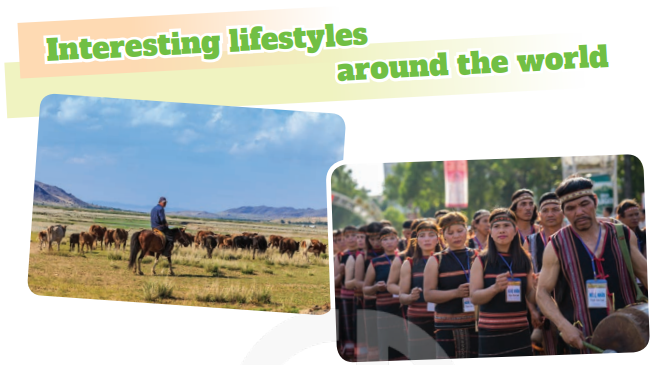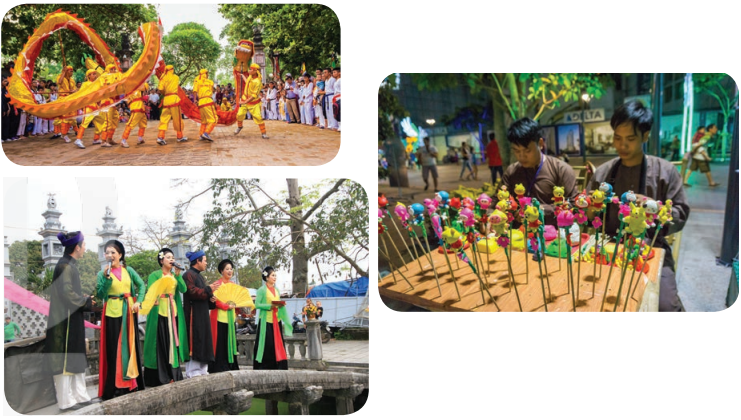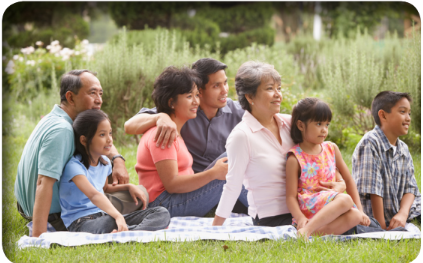
Work in groups.
(Làm việc theo nhóm.)
1. Find information about an interesting way of life around the world, including:
(Tìm thông tin về lối sống thú vị trên khắp thế giới.)
- everyday life (đời sống mỗi ngày)
- ways of cooking (cách thức nấu ăn)
- making crafts (làm đồ thủ công)
- folk songs and dances (múa hát dân gian)
- festivals (lễ hội)
You can refer to one of these, or you can choose your own. You may need to use the Internet to find information.
(Bạn có thể tham khảo một trong số này, hoặc bạn có thể chọn của riêng bạn. Bạn có thể cần sử dụng Internet để tìm thông tin.)
- Life of residents in Coober Pedy, Australia
(Cuộc sống của cư dân ở Coober Pedy, Australia)
- Nomadic life in Mongolia
(Cuộc sống du mục ở Mông Cổ)
- Life of the Ede ethnic group of Viet Nam
(Đời sống của dân tộc Ê Đê Việt Nam)
Everyday life: The life of Mongolian is punctuated by caring animals. A Mongolian nomadic family has five types of animals: horses and sheep for hot season and cows, camels and goats for cold season.
Several times during the year, according to the needs of livestock and pasture conditions, nomadic families move their yurts.
In summer, the nomadic family will favor a location near a river, to ensure water supply for the family and herds, and good pastures.
In winter, the priority is given to protection against the intense cold of Mongolian winter, and the family settles its "winter" camp sheltered from the wind in a small valley or at the edge of a forest.
The woman is very busy with the household, kitchen, 2 or 3 children, and milking the mares, cows... at least five times a day.
The husband watches the herds of yaks, horses, cows and sheep scattered on often significant surfaces and must gather them every night to protect them against the wolf attacks, frequent in Mongolia.
He also deals with equipment maintenance and repairs.
Ways of cooking: In traditional Mongolian cooking, seasoning was not used; although salt was there a long time and it is used it even in tea! Typically, they cook with a wok and most of the foods are either boiled or stir-fried.
Since a lot of livestock is raised in Mongolia, it is no mystery that Mongolian cuisine revolves around them. Sheep and goat are most popularly which are either grilled or boiled. Traditionally soup and dumplings used to be in all the courses of the meals, without which, it was regarded to be incomplete.
There are many types of crafts can be found in Mongolian culture: wooden sculptures, ger - nomadic dwelling, metalwork, embroidery art, leather crafting, art of jewelery.
The traditional masterpiece of Mongolian is the urtyn duu accompanied with the morin-khurr. Most famous Mongolian dance are: Jinai dance (milking dance), the Caihong dance (rainbow dance), the Zhongwan dance (bowl dance), the Kuaizi dance (chopsticks dance), and the Andai dance
There are lots of festival in Mongolia but these are the most well-known one: Tsagaan Sar (Lunar New Year); Khovsgol Ice Festival; Naadam Festival; Gongoriin Bombani Hural; Ölgii Eagle Festival.
Tạm dịch:
Cuộc sống của gia đình người Mông Cổ thì phụ thuộc vào sức khỏe của đàn gia súc và được nhấn mạnh bằng việc chăm sóc chúng. Một gia đình người Mông Cổ có năm loài động vật là ngựa, cừu, bò Tây Tạng, lạc đà và dê. Theo sự cần thiết về gia súc và chỗ chăn thả, các gia đình du mục di chuyển chỗ ở của mình. Vào mùa hạ, các gia đình du mục sẽ thích những nơi ở gần sông, để đảm bảo nguồn nước cho gia đình và đàn gia súc và có chỗ chăn thả tốt.
Vào mùa đông, mục đích chủ yếu là bảo vệ khỏi cái giá lạnh của mùa đông Mông Cổ, người ta sẽ xây chỗ trú đông tránh gió trong một ngọn đồi nhỏ hay bìa rừng. Người vợ rất bận bịu với công việc nhà, bếp núc, con cái và vắt sữa ngựa, bò… ít nhất 5 lần một ngày. Người chồng thì chịu trách nhiệm trông coi đàn bò, ngựa, cừu, rải rác trên một khu rộng lớn, và phải gom chúng lại vào mỗi đêm để bảo vệ chúng khỏi sự tấn công của chó sói, điều thường thấy ở Mông Cổ. Ông ấy cũng giải quyết việc giữ gìn và sửa chữa dụng cụ.
Người Mông Cổ không dùng gia vị khi nấu ăn; dù là muối đã xuất hiện từ rất lâu và nó còn được dùng với trà. Thường thì họ sẽ nấu trong một cái chảo lớn và hầu hết đồ ăn là luộc hoặc xào. Phổ biến nhất là thịt dê và thịt cừu được nướng hoặc luộc. món súp truyền thống và súp được dùng ở trong tất cả các bữa ăn.
Có rất nhiều loại đồ thủ công có thể tìm thấy trong văn hóa của người Mông Cổ như là: chạm khắc gỗ, làm ger, kỹ nghệ sắt, đồ thêu, làm đồ da, làm trang sức.
Kiệt tác truyền thống của người Mông Cổ chính là bài hát có tên là urtyn duu được đệm bằng đàn morin-kurr, Các điệu múa truyền thống của người Mông Cổ gồm: điệu Jinal (múa vắt sữa), điệu Caihong (múa cầu vồng), điệu Zhongwan (múa tô), điệu Kuaizi (múa đũa), và điệu Andai). Có rất nhiều ngày lễ ở Mông Cổ nhưng những lễ này là phổ biến nhất như Tsagaan Sar (Tết Nguyên Đán), Lễ hội băng ở hồ Khovsgol, Lễ Na-đam, Gongoriin Bombani Hural (Hội Đua ngựa), Lễ hội Đại bàng Vàng.

Các bài tập cùng chuyên đề
5. Greetings around the world. Take the quiz.
(Chào nhau trên khắp thế giới. Giải câu đố.)
1. Which is probably the most common way of greeting around the world?
A. Shaking hands.
B. Sticking out one's tongue
2. In the USA, people greet each other by _____.
A. shaking heads
B. saying "Hello"
3. Thais greet their elders by saying "sawadee" and _____.
A. saying their surname
B. slightly bowing to them
4. The Maori of New Zealand greet each other by _____.
A. kissing each other's cheek
B. pressing their noses together
5. How do people in Japan normally greet each other?
A. They bow to each other.
B. They hug each other.
2. Work in pairs. Make similar conversations to express certainty in the following situations.
(Làm việc theo cặp. Thực hiện các hội thoại tương tự để thể hiện sự chắc chắn trong các tình huống sau.)
1. You ask your friend to help you with your maths homework.
(Bạn nhờ bạn mình giúp đỡ bài tập toán.)
2. You say that Vietnamese love seafood.
(Bạn nói rằng người Việt Nam rất thích hải sản.)
Cuisines around the world
(Ẩm thực trên thế giới)
3. QUIZ How much do you know about the cuisines of different countries? Do the quiz to find out.
(Đố vui. Bạn biết bao nhiêu về ẩm thực của các quốc gia khác nhau? Giải câu đố sau để tìm hiểu.)
1. Which country is famous for pasta and pizza?
A. Thailand.
B. Italy.
C. Brazil.
2. Which country is famous for kimchi?
A. Korea.
B. Portugal.
C. Australia.
3. England is well-known for _________.
A. dimsum
B. spaghetti
C. fish and chips
4. Sushi comes from _________.
A. Japan
B. Korea
C. Taiwan
5. In which country do you think kangaroo steak is common?
A. China.
B. Australia.
C. The USA.
4. Work in groups. Read the two passages and discuss the questions below.
(Làm việc nhóm. Đọc hai đoạn văn và thảo luận các câu hỏi bên dưới.)
Italy
Italy is famous for pizza. Pizza is a dish with a flat round bread base with cheese, meat, and vegetables on top. The country is also known for its spaghetti and pasta. Italy is also famous for its many types of cheese (over 400 types). There is one that allows flies to lay eggs on it, and it has a unique taste.
India
Curry is a common dish in India. It is a dish of meat and vegetables cooked in a sauce and served with rice or bread. In fact, India has a vast range of cuisines. People in some areas of India favour vegetarian food. But chicken, lamb, or goat are common in other areas. Generally, Indians avoid beef.
Do you prefer Italian or Indian food? Why or why not?
5. Work in groups. Talk about the typical food in your area. Discuss the following:
(Làm việc nhóm. Nói về các món ăn tiêu biểu trong khu vực của bạn. Thảo luận về những điều sau đây.)
- staple food (lương thực)
- favourite food (món ăn yêu thích)
- foods eaten on special occasions (món ăn vào các dịp đặc biệt)
Example: (Ví dụ)
A: What is the taple food in your area?
(Lương thực chủ yếu ở khu bạn là gì?)
B: It's rice.
(Là cơm.)
C: Yes. We have rice with most of our meals.
(Vâng. Chúng tôi ăn cơm trong hầu hết các bữa ăn.)
...
Speaking
4. Work in pairs. Look at the pictures and use the cues to talk about what people in some places do to maintain their traditional lifestyle.
(Làm việc theo cặp. Nhìn vào các bức tranh và sử dụng các gợi ý để nói về những gì người dân ở một số nơi làm để duy trì lối sống truyền thống của họ.)
1. Chau An Village: (Thôn Châu An)
- performing traditional dances
(biểu diễn các điệu múa truyền thống)
- holding festivals
(tổ chức lễ hội)
2. Dam Ri Village (Thôn Đạm Ri)
- cooking and selling traditional food
(nấu ăn và bán thức ăn truyền thống)
- making crafts
(làm đồ thủ công)
3. Son Ca Village (Làng Sơn Ca)
- weaving clothing (dệt vải)
- singing folk songs (hát dân ca)

Example: (Ví dụ)
A: What do people in Chau An Village do to maintain their traditional lifestyle?
(Người dân ở Làng Châu An làm gì để duy trì lối sống truyền thống của họ?)
B: They perform traditional dances. They also...
(Họ biểu diễn những điệu múa truyền thống. Họ cũng...)
5. Work in pairs. Ask and answer about how people in your area maintain their traditional lifestyle. You can use the ideas in 4 and the reading text in 1.
(Làm việc theo cặp. Hỏi và trả lời về cách mọi người trong khu vực của bạn duy trì lối sống truyền thống của họ. Bạn có thể sử dụng ý tưởng trong phần 4 và bài đọc trong phần 1.)
Listening
1. Work in groups. Which of the following do you think is more influenced by modern technology? Tick ✓ your choice(s).
(Làm việc nhóm. Bạn nghĩ điều nào sau đây bị ảnh hưởng nhiều hơn bởi công nghệ hiện đại? Đánh dấu ✓ lựa chọn của bạn.)
- ways of communicating
- traditional food and drink
- ways of learning
2. Work in groups. Make a poster to introduce the people.
(Làm việc nhóm. Làm poster giới thiệu nhóm người.)
3. Give a presentation to the class.
(Thuyết trình trước lớp.)
5. In pairs, describe the daily rountines of people in your house. What do they do?
(Theo cặp, mô tả thói quen hàng ngày của những người trong nhà bạn. Họ làm gì?)
I live with my parents and my dog. Mums get up early every day. She’s a dentist …
(Tôi sống với bố mẹ và con chó của tôi. Mẹ dậy sớm mỗi ngày. Cô ấy là nha sĩ …)
1. Look at the photo. Do you think the boys are family members or friends?
(Nhìn vào bức hình. Bạn có nghĩ rằng các chàng trai là thành viên gia đình hoặc bạn bè?)

6. Choose a photo in your family’s photo album. Bring it to class and describe the photo to the class.
(Chọn một bức ảnh trong album ảnh của gia đình bạn. Mang nó đến lớp và mô tả bức ảnh cho cả lớp.)

2. Work in pairs. Take turns to ask and answer, using the following information.
(Làm việc theo cặp. Thay phiên nhau hỏi và trả lời, sử dụng thông tin sau.)
1. - How / life / that mountainous village?
- Very peaceful.
2. - prefer / life / big city?
- No. I / like / country life / better.
3. - What / you / do / if / no Internet connection / tomorrow?
- read books / play outdoors.
4. - What / you / do / have / healthy lifestyle?
- I / exercise / sports / diet / sleep.
3. Work in groups. Talk about the following topic: Modern lifestyle in our country is different from that in the past. You can refer to the following.
(Làm việc nhóm. Thảo luận về chủ đề sau: Lối sống hiện đại ở nước ta khác với trước đây. Bạn có thể tham khảo sau)
- food and cooking (thức ăn và nấu nướng)
- ways of learning (cách học)
- clothing (quần áo)
- festivals (lễ hội)
- way of learning (phương pháp học)
- …






